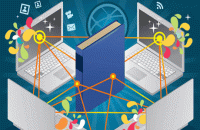6 Open Educational Resources
Your content has been saved!
Go to My Saved Content.There's a subtle but steady shift happening in classrooms across the nation. More and more, schools are seeking efficient, cost-effective alternatives to using paper and supporting over-priced textbook companies. One way is by supporting technology in schools. Schools are seeking ways to upgrade and sustain wireless infrastructures and integrate mobile devices that broaden teaching and learning opportunities. Similarly, schools are decreasing their dependency on paper and incorporating digital workflows.
Setting the Stage for Creative Exploration and Inquiry
What's exciting about this shift in content curation, creation and distribution is that it allows teachers opportunities to work with the most current information available and serve as the expert when vetting content. Many new teachers are handed a textbook and curriculum map, and then sent into the classroom. While this process provides structure, it limits current information and assumes that we believe exactly what the textbook company is presenting. This is not to say textbook companies are in the business of writing skewed versions of history, science or math, but rather that students are provided with one viewpoint on the subject.
Time is the hurdle here. The process I described above gives us both content and time, but it's limiting. The best approach to gaining time is working together and making connections. Digital, collaborative environments such as wikispaces, Google sites and docs, blogs, etc. allow teachers to connect and share over a common goal any time, anywhere. The best part is that collaborative spaces don't require a curriculum day or even a room for teachers to engage in a single space and develop digital content in an ongoing process.
Once you narrow down your digital collaboration space, the next hurdle is content. Textbooks and curriculum guides make it easy to grab and go -- fast food for new and experienced teachers when it comes to content. Many times the act of learning from a textbook or a worksheet is monotonous, mindless work for our students. It's more work than learning and, more often than not, they're following a linear path to an answer. The opportunities for creative exploration and inquiry are limited.
Resources for Exploring, Sharing and Integrating
In my classroom experience, what I have found most useful are open educational resources (or OER) -- content generated by professionals, academics and authors who have done some of the work for us. OER provide different viewpoints and angles to content that was previously static and myopic. Many OER sites are curated and maintained by non-profits who may or may not seek an optional donation. These spaces usually require a username and password, and offer teachers a space to save, download and share content with others.
To start, here are some outlets providing open educational resources that teachers can begin exploring, sharing and integrating relatively quickly.
Curriki
Curriki is a website that curates content in a variety of disciplines, highlighting noteworthy teachers and content. Membership is free, and users can sign in with their Google Apps or Facebook account. While Curriki is a non-profit, it asks users for an optional donation. This site integrates well with the iPad and Chromebook, and documents are available in many formats for easy viewing. Here is a testimonial on their site from Leslie G. Perry, a U.S.-based educator and blogger:
CK-12
The CK-12 Foundation offers FlexBooks, full digital texts that students and teachers can access on multiple devices in PDF, MOBI and ePub formats. This provides broad access to rich content. Here's more from the CK12 Flexbook site:
Connexions
Connexions is another free OER offering that allows users to sign up with a username and password to access a variety of modules and collections on multiple devices. Their website tells us:
Content is vetted by major organizations and universities and is accessible in PDF or EPub formats. And the display quality on an iPad in iBooks is excellent.
Smarthistory
Smarthistory is not only a clever play on words, but also a great art history resource. This site features content organized by time period, style, artist and theme. It's more of a gallery of art history than a textbook. Here's an excerpt from a description of their offerings:
MIT OpenCourseWare
The MIT OpenCourseWare site offers educators and students access to full courses designed and taught by MIT professors. Users can access the entire course library and the entire course packet. Course packets include video interviews with professors, syllabus, outlines, readings, assignments, projects and related resources. Here is a brief synopsis from the site:
OER Commons
This site offers educators a place where they can connect and share globally with other educators, and work with the curriculum those educators have shared. OER Commons offers a vast database of teacher-created curriculum. The content is vetted for credibility and provides citations for reference. Users can sign up for a free account, share their own work, and access and curate their own content.
Another Tool for Connected Educators
Integrating quality content into our classrooms is possible. Many feel that, in the absence of a textbook, teaching is directionless. What needs to be highlighted in this shift is that content area teachers are hired for their expertise in a specific subject. It is our job as educators not only to deliver content, but to provide our students with multiple lenses for evaluating and processing it.
Integrating open educational resources requires little time and research -- and, if done collaboratively, can be more efficient and effective than if planned in isolation. Part of being a connected educator is the ability to connect with each other as well as connecting our students with rich, dynamic content that provokes their thinking and enhances their learning.
